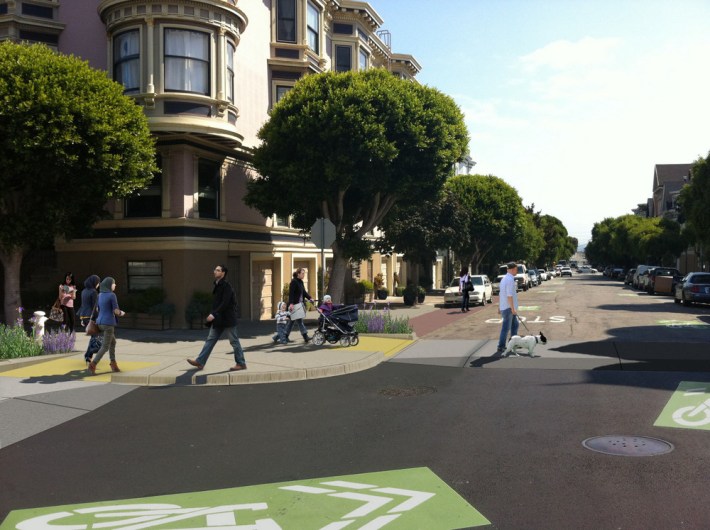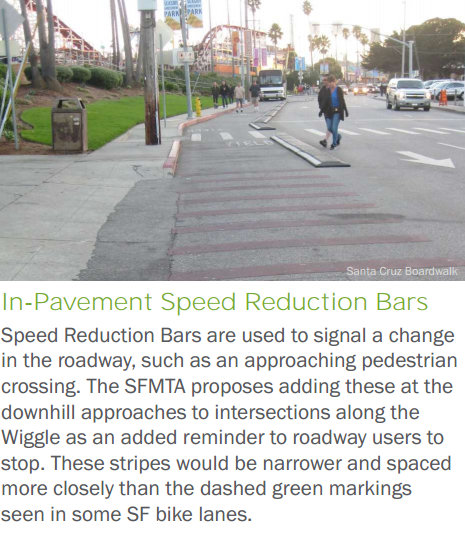
Plans to create calmer, greener streets on the Wiggle came into clearer focus Tuesday after the SFMTA presented more refined proposals for raised crosswalks and intersections, bulb-outs with greenery, traffic circles, traffic diverters, and other safety improvements.
The proposed treatments [PDF] are aimed at improving stormwater drainage while also calming motor and bicycle traffic. One newly proposed measure to help address the growing number of complaints that an increased number of bicycle commuters are making the streets uncomfortable to walk across is "in-pavement speed reduction bars" on approaches to crosswalks. Those, planners explained, would be strips of colored material much like the green-backed sharrows already along the Wiggle aimed at signaling bicycle riders to prepare to yield to pedestrians.
"We can't force anyone to stop, but there are physical improvements we can do to make it so that you can see what's coming sooner and act accordingly," said Miriam Sorrell, a planner with the SFMTA's Livable Streets team.
While the original aim of the project was to add greening improvements along the traditional Wiggle bicycle route -- topographically, the flattest way across the lower Haight -- the SFMTA and Public Utillities Commission are now considering deviating from the route for two blocks, placing improvements on a block of Pierce and Page Streets instead of the corresponding blocks of Haight and Scott Streets. That's because permeable pavement treatments that would go underneath the parking lanes on Haight wouldn't be able to bear the loads of Muni buses and delivery trucks which often stop there. Sorrell said the pavement treatments are mostly intended to absorb stormwater, though they can contribute to calming traffic by narrowing the visual width of the roadway.
"We have the most potential for stormwater management" on Pierce and Page, said Sorrell, "compared to on Haight Street where we might be limited in terms of some of those green infrastructure improvements."
The other reasons to consider the two-block deviation, SFMTA planners say, are that many bicycle riders have said they deviate on to Page and Pierce anyway, and that Scott would still have reduced car traffic if the street is blocked off to cars in at least one direction, as the agency proposes to do. The motor traffic diverters could be added on Scott at Oak or Fell Streets, creating a dead-end for drivers in one or both directions, preventing them from using Scott as a cut-through route. People walking and biking would still be allowed to filter through in both directions, and the SFMTA has also proposed adding a traffic circle at Scott and Page to calm that intersection further.
Although the proposals to divert motor traffic raised concern from some pro-parking activists at a recent meeting (even though little if any car parking would be removed), the Wiggle proposals seem mostly well-received.

"There seems to be a great deal of community support for making greening and traffic calming investments in the Lower Haight area, which many of us know fondly as the Wiggle," said Leah Shahum, executive director of the SF Bicycle Coalition. "It's great to see so many neighbors coming together to plan for calmer, safer, greener streets right outside their front doors."
Lawrence Li, a board member of the Lower Haight Merchants and Neighbors Association, said the response in the neighborhood so far seems "surprisingly, overwhelmingly good."
As a possible explanation for the warm reception, Li said, "In our neighborhood, we have a large percentage of people who rely on walking, transit and bicycling."
"A lot of these ideas would improve that experience," he said.
Although there haven't been any known injuries involving bicycles on the Wiggle recently, we continue to hear reports of SFPD stings, where officers ticket bike commuters who don't fully stop at stop signs -- even people who safely do an "Idaho stop," a practice used even by SFPD officers themselves -- which saps limited police resources but doesn't necessarily make anyone safer.
SFBC staffers took an alternative strategy to address the issue this week by heading out to the Wiggle to "thank people biking and driving for taking their turns, yielding to pedestrians and biking politely," the organization wrote in a blog post. "With such huge numbers of people biking and walking, taking turns and slowing down is crucial to keeping this corridor safe and civil for everyone."
Sorrell said raised crosswalks could be added at every Wiggle intersection with stop signs. Along lower Haight Street, existing stop signs at Scott and Pierce could be traded for traffic signals as part of the Muni Transit Effectiveness Project, which is being developed separately. That proposal is aimed at speeding up the 71 line (the signals would have transit priority), and SFMTA staff said those intersections aren't slated to get bus bulb-outs under the TEP.
The Wiggle improvements are currently scheduled to be completed in mid-2016.






